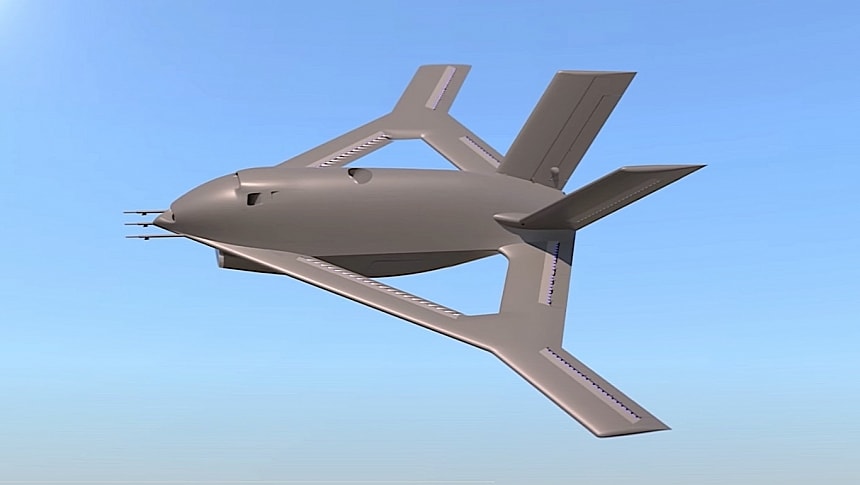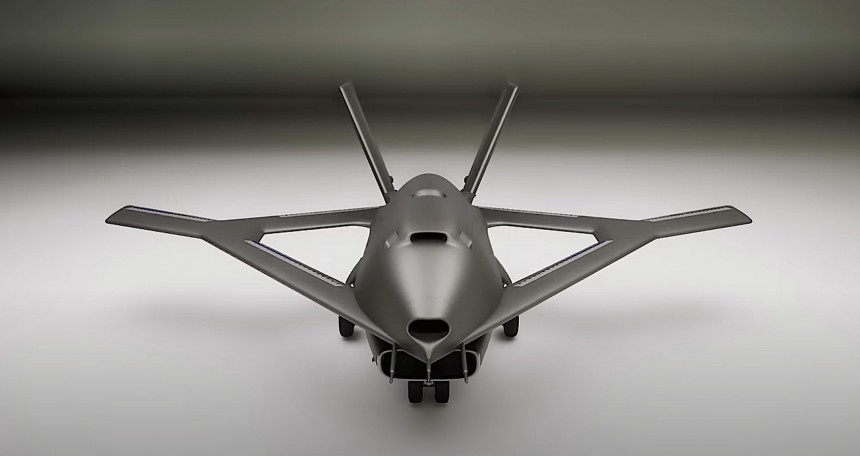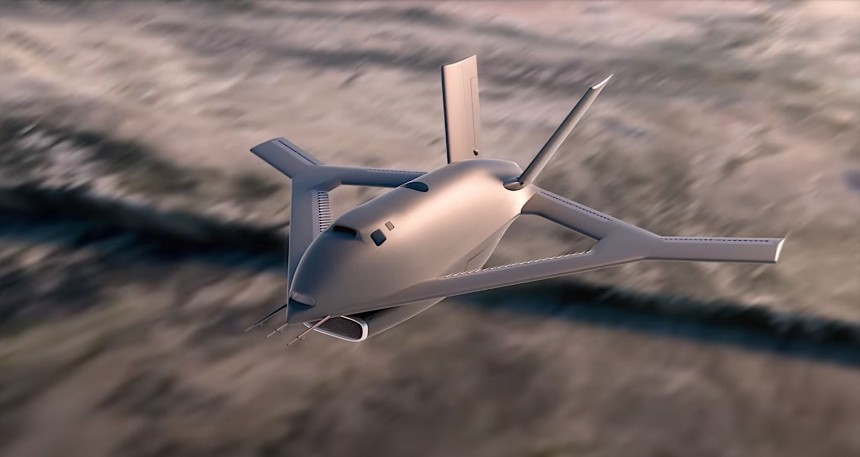One doesn't have to be an aviator to understand how an aircraft works. In simplistic terms, engines push it through the air, the wings provide lift, and various control surfaces like stabilizers, rudder, flaps, ailerons, and slats allow the plane to climb, descent, bank, or roll.
That's how planes have been doing their thing for more than 120 years now, and it's a system that works. However, the American research agency that goes by the name DARPA seems to be tired of it and proposes a design that may revolutionize the industry.
At the beginning of last year we got word of DARPA looking to design a plane with no wings in the conventional sense, and no control surfaces on the airplane's tail or wings. The idea is as wacky as it is revolutionary, and it just got a major push forward in 2024.
What DARPA is essentially proposing is ridding a plane of traditional control surfaces and using something called active flow control to allow pilots to control its roll, pitch, and yaw. In a nutshell, whereas in normal airplanes the flow of air is affected by the various positions of control surfaces, the DARPA plane would use actuators and effectors to get an extra flow of air over certain parts of the aircraft.
The project, which officially wears the name Control of Revolutionary Aircraft with Novel Effectors (CRANE), just entered Phase 3 this year, and the contractor that's been on board ever since the beginning was selected to build a full-scale experimental aircraft (uncrewed) to test the idea and its potential benefits.
The contractor is called Aurora Flight Sciences, and it is a research subsidiary of Boeing. The company has until next year to come up with a design and an actual product. DARPA calls the experimental airplane X-65, and considers it a technology demonstrator.
As per details provided by the agency, the X-65 will be built with a diamond-like wing shape (there are actually four wings with varying sweep angles) that supposedly will help maximize the impact of active flow control. It will weigh over 7,000 pounds (3,175 kg) and it will have a wingspan of 30 feet (nine meters). The top speed it will be able to reach, courtesy of engines whose nature was not disclosed, will be Mach 0.7 (537 mph/864 kph).
The above numbers make the X-plane not unlike a military trainer aircraft, and that should help with making whatever lessons are learned immediately applicable in the real world.
Aurora will build the plane with both traditional flaps and rudders and active flow control effectors, with the latter bunch spread all over the lifting surfaces. This approach was chosen in a bid to minimize risk, because no one really knows how active flow control will actually work in the test plane.
At first, the X-65 will be flown and controlled with the traditional hardware, and that will serve as a baseline. Later on, these control surfaces will gradually be locked down, and effectors will be gradually engaged until, hopefully, a complete switch from one to the other is made.
The switch from one control method to another will be made possible by the fact the X-65's hardware will be modular. But modularity also means that if someone wants to test the tech on a different aircraft, they could easily do so. All they have to do is remove the wing sections and the effectors themselves and install them in the new test vehicle.
Back to the X-65, when in active flow control mode the airplane will use jets of air that will be blasted from a pressurized source of an undisclosed nature. These jets will shape the flow of air to get the desired roll, pitch, and yaw.
Why is DARPA doing this? There is no actual nefarious reason behind the idea, just a quest to reduce the weight and complexity of aircraft (no control surfaces mean no moving parts on the exterior of the plane), thus increasing performance. And there's no better way to do that than with a full-scale aircraft in a real-world environment.
So, what is the status of the X-65? According to the available information, Aurora Flight Sciences is already hard at work putting the aircraft together. We're told the plane should roll out on the tarmac for the first time at the beginning of 2025, and should take to the skies just a few months later, in the summer of next year.
At the time of writing, there is no timetable for the test flights, nor do we have any reason to believe the design will turn into a usable commercial or military aircraft anytime soon. That doesn't make it any less spectacular, though, given what it set out to achieve, and that means we'll be keeping an eye out for new developments and update as soon as we learn of them.
At the beginning of last year we got word of DARPA looking to design a plane with no wings in the conventional sense, and no control surfaces on the airplane's tail or wings. The idea is as wacky as it is revolutionary, and it just got a major push forward in 2024.
What DARPA is essentially proposing is ridding a plane of traditional control surfaces and using something called active flow control to allow pilots to control its roll, pitch, and yaw. In a nutshell, whereas in normal airplanes the flow of air is affected by the various positions of control surfaces, the DARPA plane would use actuators and effectors to get an extra flow of air over certain parts of the aircraft.
The project, which officially wears the name Control of Revolutionary Aircraft with Novel Effectors (CRANE), just entered Phase 3 this year, and the contractor that's been on board ever since the beginning was selected to build a full-scale experimental aircraft (uncrewed) to test the idea and its potential benefits.
The contractor is called Aurora Flight Sciences, and it is a research subsidiary of Boeing. The company has until next year to come up with a design and an actual product. DARPA calls the experimental airplane X-65, and considers it a technology demonstrator.
The above numbers make the X-plane not unlike a military trainer aircraft, and that should help with making whatever lessons are learned immediately applicable in the real world.
Aurora will build the plane with both traditional flaps and rudders and active flow control effectors, with the latter bunch spread all over the lifting surfaces. This approach was chosen in a bid to minimize risk, because no one really knows how active flow control will actually work in the test plane.
At first, the X-65 will be flown and controlled with the traditional hardware, and that will serve as a baseline. Later on, these control surfaces will gradually be locked down, and effectors will be gradually engaged until, hopefully, a complete switch from one to the other is made.
The switch from one control method to another will be made possible by the fact the X-65's hardware will be modular. But modularity also means that if someone wants to test the tech on a different aircraft, they could easily do so. All they have to do is remove the wing sections and the effectors themselves and install them in the new test vehicle.
Why is DARPA doing this? There is no actual nefarious reason behind the idea, just a quest to reduce the weight and complexity of aircraft (no control surfaces mean no moving parts on the exterior of the plane), thus increasing performance. And there's no better way to do that than with a full-scale aircraft in a real-world environment.
So, what is the status of the X-65? According to the available information, Aurora Flight Sciences is already hard at work putting the aircraft together. We're told the plane should roll out on the tarmac for the first time at the beginning of 2025, and should take to the skies just a few months later, in the summer of next year.
At the time of writing, there is no timetable for the test flights, nor do we have any reason to believe the design will turn into a usable commercial or military aircraft anytime soon. That doesn't make it any less spectacular, though, given what it set out to achieve, and that means we'll be keeping an eye out for new developments and update as soon as we learn of them.

















